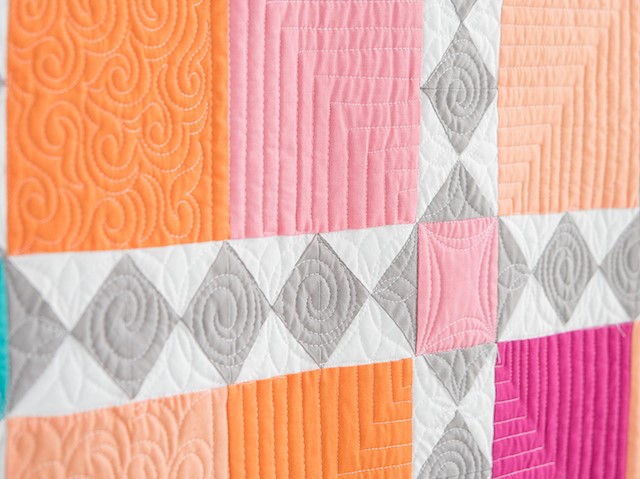
The terms "crazy stitching" and the "crazy quilting", both are frequently used interchangeably. Both terms refer to the same type of textile art. These colorful quilts were first made by women of the upper class using a base cloth. This method is becoming increasingly popular as a way for quilters to express themselves. This article will discuss the history of crazy stitching and crazy quilting. This article will explain how and why it was invented, as well as what it meant to quilters.
Crazy quilts were made of irregular shapes with no repeating motifs
Crazy quilts originated from wealthy women who had the resources and time to make them. They were made by wealthy women who shared the skills with their less well-off relatives. They are still made occasionally today by patchworkers from around the globe. Their popularity has decreased, but their designs remain popular for display. Here are some facts to know about crazy quilts.

They were made by upper-class women.
Crazy quilts were first made in Philadelphia after the Centennial Exposition. In 1876, women became more interested in Japanese art. Many upper-class women used needlework as a form of recreation, while servants performed the monotonous tasks. Crazy quilts were intricate and required a variety of fabrics. This led to the widespread use of silk and lace. It took a lot of time to finish Crazy quilts, which were often embroidered using decorative embroidery stitches.
They were decorated by beads
Crazy quilts were originally made of random pieces and did not have a predetermined design. It was common to save pieces for clothes for the family. A row of plaid woolens could be sewn alongside a row of red woolen, underwear. These quilts were decorated often with other fabrics such as silk and velvet. Beads were an important part of crazy quilts in Victorian times.
They were assembled on a foundation blanket.
Many of today's Crazy quilts are constructed of pieces of fabric that have been randomly pieced together and embellished with decorative embroidery. Many include pre-embroidered appliques and ribbons. Crazy quilts were popular in the 1880s, when brightly colored fabrics were widely available. The use of woolens decreased the need for embroidery, so it was reduced to covering seams. Some women still worked in crazy quilting and transformed them into amazing wall hangings.
They were tied
Crazy quilts rose in popularity during the Civil War. These were used as sanitary fundraisers by military hospitals. These fundraisers saw women sew together patches, batting, and other items that represented an event in their lives. Quilts could often include the donor's name and birth date. Sometimes, a sentiment would be added to the quilt. Although some of these crazy quilts are now obsolete, many remain popular today.

These were made from small pieces of fabric
A "crazy Quilt" is a quilt made from pieces of fabric that aren’t suitable for sewing. The patterns are typically random and there's no plan. It was not uncommon for parents to make clothing for their children, and save odd-shaped pieces in order to make quilts. A plaid woolen shawl, for example, might be stitched next to a triangle cut from red underwear.
FAQ
How do I find a hobby to pursue?
At first, it may seem like there is nothing you can do.
You might be thinking "I'm not very creative" or "I am terrible at sports" or even "I don’t know anything”.
But the truth is, you probably already have a lot of experience to draw upon when looking for a hobby.
It's just that you haven't realized it yet.
Take a good look at what you have in your house. How much stuff are you able to store?
Do you have any old toys lying around that could be used?
Perhaps you have a collection.
Perhaps you have always wanted to be a chef.
Maybe you want to get back into playing the guitar.
Whatever it is, there's likely something you can turn into a hobby.
The secret is to remember that you already have plenty to draw on.
Once you have done that, you will be able choose a hobby that suits your lifestyle.
What are some good hobbies?
You can find the best hobbies that you love doing for yourself. You'll be more motivated to do what you love. You will have a reason when you feel sick or tired.
Hobbies that we all know and love include gardening, painting and crafts, photography, cooking, sports and games, reading, music, film-making, collecting, cycling, walking, dancing, writing, playing instruments, etc.
You might also consider volunteering at a local charity shop or animal shelter, children’s hospital, hospice, elderly home, school, community centre, church, and other places.
You might be looking for something more adventurous. Try scuba diving, rock climbing or parasailing.
You can spend your time outdoors in many different ways, including spelunking, snowshoe hiking, snowshoe hiking and more. These include caving.
How can I get started in my new hobby?
You must decide what hobby you want before you start any new hobby.
Passion is essential once you have selected your subject.
Understanding why you are interested in a hobby is important. This will help give you direction and provide a purpose.
Once you've chosen the hobby you would like to pursue you can start planning.
Think about the equipment that will be needed.
You should consider whether or not you will need to take classes or attend seminars.
Make sure you have enough space for your hobby.
You might also consider joining a club. These groups are often supportive and offer advice.
Also, consider how much money your hobby would cost.
What is a collection hobby?
Books, movies, music and comics are the most popular collections.
Also, you can collect anything: stamps, coin to cars, dolls to action figure to model kit to figurines to art materials to tools to cook utensils and jewelry to watches to jewellery to appliances to clothes to furniture or antiques to...
You get it?
Statistics
- The intensity of the dialogue partners' bond at the end of the forty-five-minute vulnerability interaction was rated as closer than the closest relationship in the lives of 30 percent of similar students. (time.com)
- I am 100% biologically a woman (discover.hubpages.com)
- The Role of the Mind in Sex, Dating, and Love: Men in the “humor” condition received phone numbers from 42.9% of the female participants and were refused 57.1% of the time. (time.com)
- Much of this decline reflects the fact that teens are less likely to work today than in the past; among employed teens, the amount of time spent working is not much different now than it was around 2005. (pewresearch.org)
- A new survey by Pew Research Center of teens ages 13 to 17 finds that 36% of girls feel tense or nervous about their day every day; 23% of boys say the same. (pewresearch.org)
External Links
How To
How to Learn a Musical Instrument
There are many different ways to learn how music is played. There are many options. You can go to school, purchase a book, learn from an instructor, or watch videos online. If you are determined to learn on your own, these tips and tricks might be helpful.
-
Find something that interests you. You don't have to like every instrument you see. It's difficult to take up a hobby if you don’t love playing the instrument.
-
Be patient. It takes time to learn something new. Expect to not be able master all things immediately. Instead, continue to practice each day.
-
Practice regularly. You can do this even when it is hard. This will ensure that your memory doesn't fade.
-
Find a quiet place to practice. A quiet room where you won't disturb anyone else is ideal. It is important to keep the room clear of distractions. Also, don't let loud music play near your home.
-
Have fun. Music should be enjoyed. Make sure you have fun while practicing. Being happy will inspire you to keep practicing.
-
Set goals. Setting goals will help you to know exactly what your goal is. There is no excuse for failure.
-
Keep track and keep track of your progress. Notate all of your achievements and failures. This will help you to improve your performance over time.
-
Take breaks. Sometimes all it takes is to take a breather. It is a good idea to take breaks so you can think about everything.
-
Ask questions. Ask for help if you are unsure or have questions about certain aspects of the instrument. They may be willing to help.
-
Listening can teach you a lot. Many musicians learn by listening to the songs they love and then imitate them. This helps musicians understand the fundamental concepts of the song.
-
Read books. Read books to learn more than just watching videos or learning from classes. Books also contain information that you cannot find elsewhere.
-
Get involved in a band. You'll be more motivated to practice when you are playing with others. Plus, you'll meet people with the same interests as you.
-
View tutorials. Tutorials are short videos that give detailed information on a topic. These videos usually focus on one specific aspect of the instrument. Watching tutorials can help you understand difficult parts of the instrument.
-
Explore different learning methods. Some people prefer to learn through lectures, whereas others learn better by reading. You can experiment until you discover what works for you.
-
Practice makes perfect. You don't become an expert overnight. Instead, you must put in lots of effort before becoming skilled enough to perform well.
-
You can learn from other musicians. Listening and learning from others can help you to learn faster.